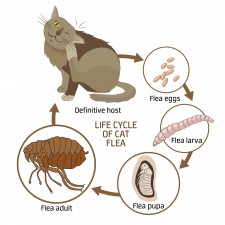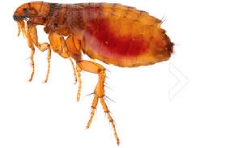About 1,400 species of fleas have been identified and there are perhaps up to 60 species in Britain. All adult fleas are wingless, flattened laterally (i.e tall and thin) and vary in colour from greyish through to a dark mahogany. Their mouth is well-adapted to sucking blood from the host animal and most species are partially clothed with backward facing bristles and spines. These characteristics and their generally narrow-front, pointed shape enable them to burrow in and amongst the hair, fur or feathers of the host but make them difficult to remove by scratching or preening. An important characteristic of adult fleas is the adaptation of the hind legs into very muscular organs which are capable of projecting the flea vertically a considerable distance.
The adults are blood-sucking and therefore parasitic but flea larvae are not. The larvae live on detritus, dust and fluff, animal protein in the form of skin scales and feathers and especially on the blood-rich droppings from adult fleas.
Human Flea | Cat Flea | Dog Flea | Oriental or Tropical Rat Flea | Bird Flea | Rabbit flea | Cable Bugs
Egg – larva – pupa – adult.
Up to 1000 eggs per female, 1mm long, white, laid after a blood meal in small batches amongst the fur of the host. They usually drop off the host onto the floor or among bedding. hatch in a few days.
Larvae – legless, whitish up to 5mm long, thrive best in humid places in host bedding or on floor. 2-3 moults, fully grown in about 3 weeks.
Pupa – in cocoon spun by larvae. Normal emergence in 2-4 weeks in response to vibration, delayed by up to several months if not stimulated.
Adults – about 2mm long , brown, wingless, laterally flattened and with large hind legs for jumping.
The human flea is widespread throughout Britain but appears to be becoming rather rare and sporadic in its occurrence with the general improvement in hygiene. The adult flea is an ectoparasite of man but is also commonly found on some wild animals such as Badgers, Foxes and Hedgehogs and frequently occurs in great numbers in piggeries.
Cat Flea ( ctenocephalides felis )
The Cat Flea is cosmopolitan and is found widely throughout the British Isles. It is by far the commonest of the flea species that comes in contact with man, and despite its name it is also commonly found on dogs. The adult cat flea spends a variable proportion of its time off the host.
There is very little difference in physical appearance or in habits between the Dog Flea and the Cat Flea. Both species are inter-changeable from one host to the other and both species will readily bite humans. The Dog Flea is less common in the UK than the Cat Flea, but in most other respects is very similar.
This species is infamous for its having spread the Bubonic Plague or Black Death throughout Europe and Britain twice over the past few hundred years: once in the 14th century (the Black Death) and again as the Plague of London in the 1660s.The adult flea readily bites humans, making it an important vector of rodent borne diseases. One important difference is that the Rat Flea tends to spend most of its time on the host animal, in contrast to the Human Flea that spends little of its time on humans.
Several ceratophyllus species occur and are mostly host specific, they seldom feed on man.
This species is found on domestic and wild Rabbits where it normally remains attached to the ears. It is the main vector of myxomatosis in Britain.
There is a phenomenon that can occur in office situations where staff claim to have been bitten at work, but the culprit cannot be found. The scenario is often similar with there being open plan offices, synthetic nylon carpets, a large amount of electrical equipment and often a dry atmosphere. Staff complain of bites on legs and are able to show red marks, which are similar in appearance to insect bites.
Wyre Forest Pest Control are experts at treating flea infestations.
Wyre Forest Pest Control guarantees all treatments, we offer a professional service with a quick response time.
Please phone to arrange your survey or for expert advice, 01562 747210 or 07890048362.






